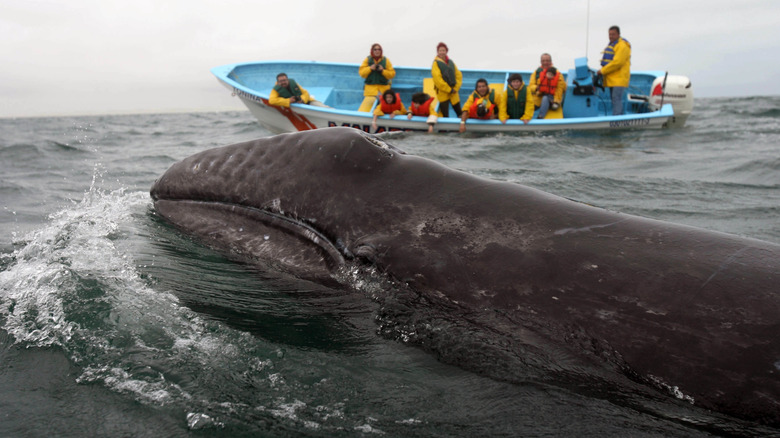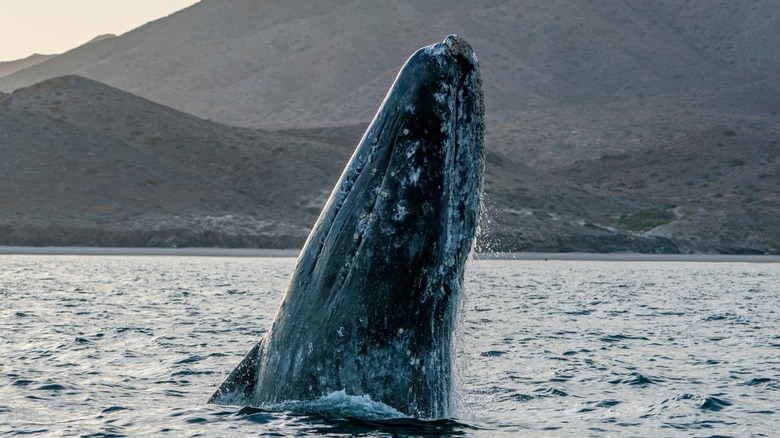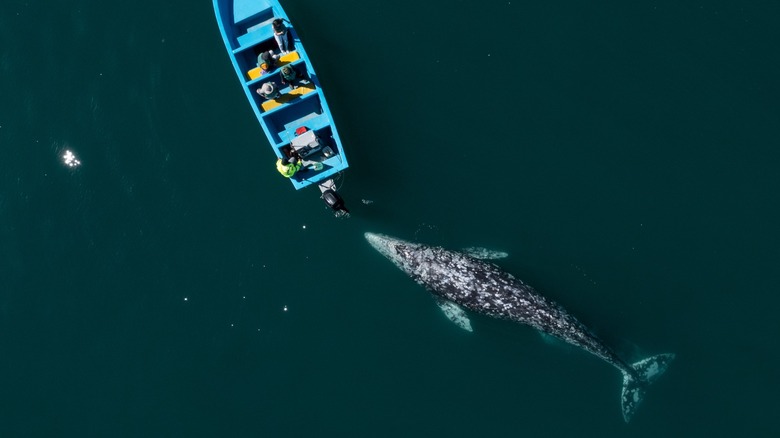Playful Gray Whales Swim Right Up To Tourist Boats At Latin America's Largest Wildlife Reserve
In the southern reaches of a peninsula that juts out 760 miles into the North Pacific Ocean lies Baja California Sur, Mexico's least populated state and the last one to join the country. However, it may be the most well-known state, due to the presence of tourist hotspots like Los Cabos, which is one of the safest destinations in Mexico for a vacation. It is also the site of several of the country's best beaches, according to travelers.
But beyond its stunning shoreline and grand hotel chains, Baja California Sur is home to the largest wildlife reserve in Latin America: El Vizcaíno Biosphere Reserve, where you can get an up close look at gray whales. This unique environment contains several distinct ecosystems, including desert, plains, mountains and coastal areas, each of which holds a variety of flora and fauna. According to UNESCO, there are 463 plant species (37 of them endemic to Baja California Sur), over 60 species of mammals, and 135 species of migratory birds who shelter here.
This biodiversity is so important that the area was turned into a nature reserve. And although all the creatures inside it play a special role in the ecosystem's health, the North Pacific gray whale is particularly integral. They are bottom-feeders, creating mud plumes during their search for food that release essential nutrients for other marine life. They also bring up crustaceans from the ocean floor, which seabirds hungrily await. Every year, thousands of these gentle giants migrate more than 12,000 miles from the Arctic to two El Vizcaíno lagoons: their annual breeding sites and nurseries. You can see the whales from January until mid-April in Laguna San Ignacio and from February until the end of March in Laguna Ojo de Liebre. In 1993, these lagoons were placed on the World Heritage List as the Whale Sanctuary of Vizcaíno.
Visiting the Whale Sanctuary of Vizcaíno
In the early 20th century, the North Pacific gray whale was near extinction, with just over 100 animals left. Commercial whaling and other human impacts had nearly decimated them for good. While the species has slowly recovered over time, the whale population is still threatened today by the effects of climate change. The sanctuary's purpose is to mitigate these negative impacts through protecting the whales and managing any challenges that pose threats to their population.
But whale-watching excursions are allowed in the area, as they raise awareness of the plight of these animals and bring in money to the community that works to protect them. Going on a tour to see the North Pacific gray whale up close is an opportunity you shouldn't miss.
There are several things to be aware of when you book your whale-watching expedition. Only 16 small boats are allowed at a time and must remain in a particular zone, so your guide will not be permitted to chase the animals — it is up to the whales whether they want to approach you. That being said, gray whales are known for being curious and playful, with mothers often coming up to the boats with their calves to breach or people-watch. While many previous visitors reported being able to pat the whales, experts strongly recommend against touching marine life. The chemicals on your hands (for example, from sunscreen) can harm them, you may incur the wrath of Mama Whale if she views you as a threat to her calf, and there is the possibility of transferring zoonotic diseases. So just sit back, relax, and enjoy the beauty of the lagoon and the company of these friendly, majestic creatures from the comfort of your "panga" (fishing boat).
Getting to El Vizcaíno
To get to El Vizcaíno, you can either base yourself in San Ignacio or Guerrero Negro, both located in Baja California Sur. Tour operators, with whom you can book your trip, will be available in both cities. If you're in San Ignacio, you'll be taken to Laguna San Ignacio, about an hour and a half away, and if you're in Guerrero Negro, you'll head to Laguna Ojo de Liebre, a much shorter 30-minute drive away. While neither town is developed to the extent of Los Cabos, with its expanse of five-star luxury resorts, both offer a range of modest accommodations at a variety of price points. Guerrero Negro is much larger in both population and size, but neither place has a massive tourism infrastructure. Online reviews seemed to favor Guerrero Negro for its proximity to the lagoon, lower costs, and greater amount of wildlife, including harbor and elephant seals, sea lions, and four species of turtles.
To get to San Ignacio or Guerrero Negro, you can first fly into Loreto, one of the best and most magical towns in Mexico. To the former, it's a 3.5-hour drive, and to the latter, it's 5.5 hours from Loreto. You can rent a car, take the public bus, or opt for a private van. If you're driving, it's best to do so only during the daytime and be aware that mobile reception will be spotty (and non-existent in the area near the salt plains). From the U.S. mainland, there are direct flights from several cities to Loreto, including L.A., San Diego, San Francisco, Phoenix, and Dallas. It is best to plan and book your trip well in advance, as previous visitors noted that accommodations and tours can book up quickly, especially during high season.


